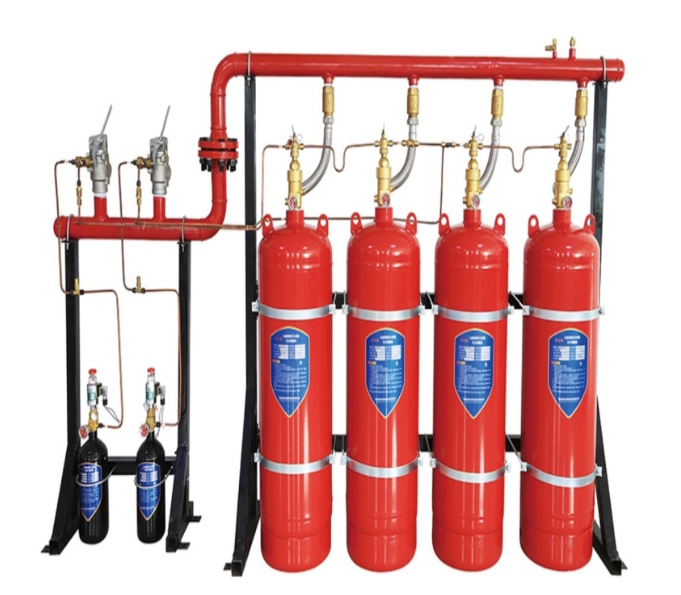Copyright © 2021TANDA Development Pte. Ltd. All rights reserved.Privacy Policy.Site MapDesigned by

Extinguishing fires with water or foam is not possible in some industries since these extinguishing chemicals would ruin or leave the object useless.
Museums, libraries, and archives, as well as computer and server rooms, are all examples of this. Extinguishing gases are employed in these situations.
Gas extinguishing systems have versatile uses and as such the type of extinguishing gas to employ is determined by the intended usage.
You'll need to work with a reputable and dependable gas extinguishing system manufacturer to choose the ideal device.
The following are the numerous gases that can be used to put out a fire:
Chemicals like HFC-227ea and FK-5-1-12 are utilized in clean agent extinguishing systems.
Because clean agents do not damage components, they are widely employed to put out fires in mechanical and electrical equipment.
They are safe for people and can also be used to safeguard occupied locations like electrical rooms.
Clean agents are environmentally friendly; they do not deplete ozone and have a low global warming potential when compared to alternatives.

Another popular gas utilized in fire suppression systems is carbon dioxide. Carbon dioxide, like clean agents, does not require clean-up after emission.
Carbon dioxide, unlike clean agents, extinguishes fires by removing oxygen rather than heat.
This is a significant distinction since it means carbon dioxide cannot be used in occupied areas. Carbon dioxide suffocates people because it depletes oxygen levels.
If you're utilizing a carbon dioxide system to put out a fire, ensure sure the area is properly ventilated if the system fails. Only then can employees safely inspect the damage.
Because of the risk of thermal shock, we don't recommend utilizing carbon dioxide to protect electronic equipment.
Carbon dioxide can be held at very low temperatures, causing thermal shock. When carbon dioxide is released, it can cause electrical components to freeze, resulting in permanent damage. Protecting electrical cabinets and other comparable equipment with clean agents is a preferable option.
Despite its drawbacks, carbon dioxide provides several significant advantages.
It is very convenient and cost-effective. To put it another way, if a system fails, it is simple to get it refilled at a fair cost.
As a result, if you feel your equipment will experience several fires during its service life, carbon dioxide may be a smart option.
EDM machines, which can be protected with a high-pressure CO2 system, are a good example of this.
Inert gases work similarly to carbon dioxide in that they remove just enough oxygen to prevent burning (or fire).
Inert gases, unlike carbon dioxide, are deemed acceptable to employ in populated spaces since they do not drop oxygen levels to the point of causing suffocation. Inert gases include the following:
So, how do inert gas and chemical clean agent extinguishing systems differ?
Chemical clean agents are stored as a liquid (FK-5-1-12) or as a liquefied and compressed gas, whereas inert gases are stored as a gas (HFC-227ea).
As a result, chemical cleaning solutions can be stored in smaller, more space-efficient containers.
Inert gases, on the other hand, flow more easily through pipelines, allowing them to be stored further from a potential fire source.
These logistical issues are crucial during the planning stages of a structure or room.
Halon gas extinguishing systems existed before the advent of clean agents and inert gases.
Halon offers many of the same advantages as clean agents and inert gases. It's inert, equipment-safe, and excellent at putting out class A, B, and C fires.
Halon, on the other hand, has been shown to destroy the ozone layer of the Earth. As a result, the Montreal Protocol outlawed it in 1989.
While some older gas extinguishing systems may still contain halon, gas extinguishing systems built in the previous 20 years are unlikely to do so.
Choosing a high-quality gas extinguishing system that is suitable for your specific purpose may not appear to be a tough task at first glance, but it is in reality, given the enormous number of products that have flooded the market.
As a result, it's critical to connect with and engage with a reputable, dependable, and trustworthy gas extinguishing system manufacturer.
We have an effective system in place at TANDA Development Pte. Ltd., which is staffed by skilled and high-tech specialists.
One of the top delivery systems in the market is ours. It can overcome any obstacle to bringing your stuff to you anywhere on the planet. Kindly check and make your order today!